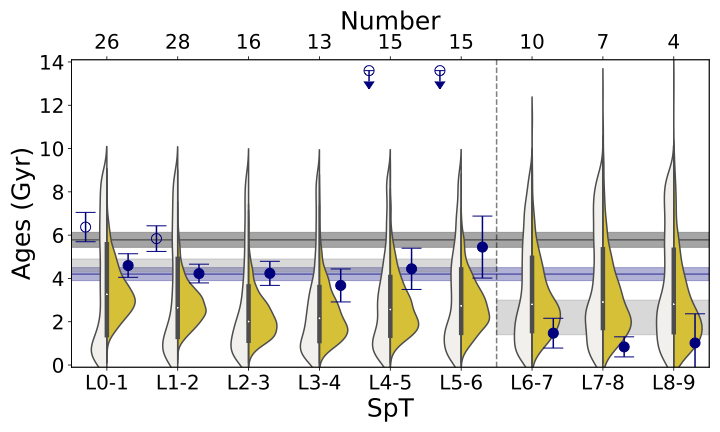Ultracool Dwarf Kinematics

The measured L dwarf age shows a break after L4-L6 subtypes, implying the kinematic evidence of the terminus of stellar Main Sequence.
Space motions of celetial objects tell us how their formation history and evolution. Using my forward-modeling method, I measured previse radial and projected rotational velocities of 37 T dwarfs. I compiled a local 3D kinematics sample of 172 late-M, L, and T dwarfs and found kinematic evidence of the stellar and substellar boundary.
Stars form in clusters and move together at their birth. Over the course of their lifetime, their group motion becomes more scattered due to the interaction of giant molecular clouds, Galactic arm, bar structures, etc, which is reflected in their velocity space. Their velocity dispersion for a given stellar population is more dispersed when they get older, astronomers have formulated an age-velocity dispersion relation to measure their ages. Assuming ultracool dwarfs (i.e. late-M, L, and T dwarfs) follow the same relation, I measured their kinematic ages using the radial velocities and associated astrometric measurements, as well as their tangential motions.
With a statistically sufficiently large sample (our T dwarf RV sample is four times larger than any of the local T dwarf RV measurements), the derived kinematic ages of late-M and T dwarfs are consistent with the simulations. However, the measured age of L dwarfs is highly inconsistent with the simulations, which was also reported in the literature. Looking more closely into the L dwarf kinematic distribution as a function of spectral subtype, we found that there is a relatively high fraction of older population within the L dwarfs, removal of these older L dwarfs brings the measured age consistent with the simulations. These older L dwarfs are all earlier than L6 subtypes in the sample, and the older L dwarfs can be interpreted as the lowest-mass stars (so they are older also in kinematics). This is the first kinematic evidence of the stellar and substellar boundary (nicely covered by Science News) while future observations are needed to validate our claim.